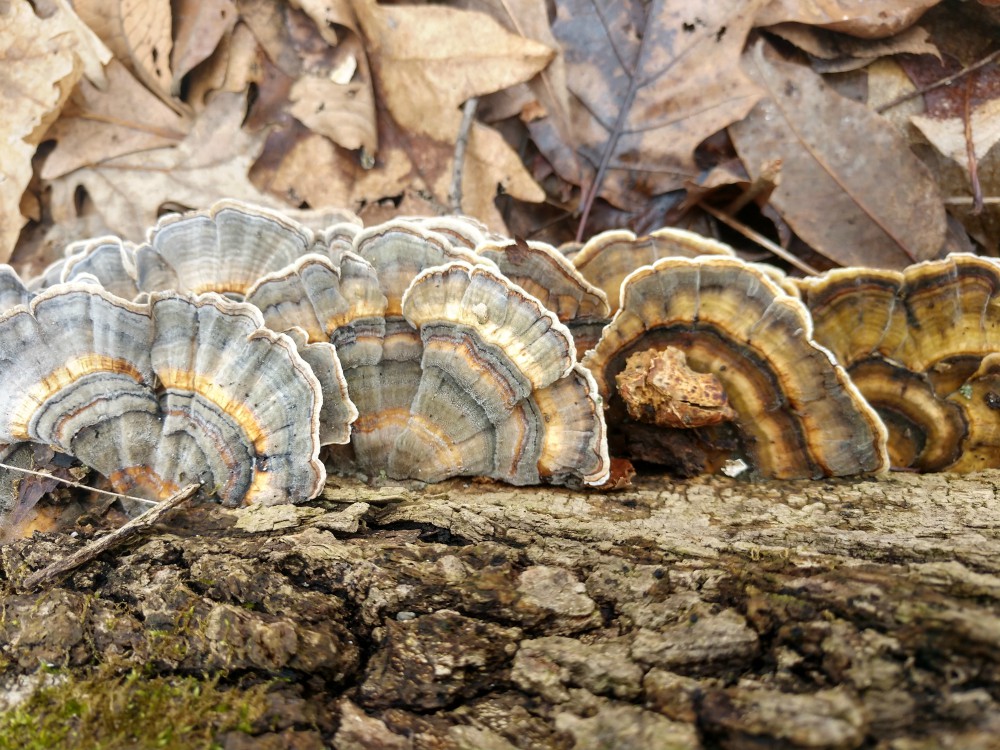As forests grow colder and seasons change, so too does your experience on a hiking trail. The once lush green woods turn to frosty earth tones.
It may seem like forest life simply sleeps through the winter, but if you know where to look, you can still see it. Sure, you can observe life thriving under leaves, rocks, or soil. But simpler yet, there is a certain living organism that is growing in plain sight and may just remind you of Thanksgiving!
Turkey Tails (Trametes versicolor) are a type of fungus that grow off the side of dead hardwood trees. While late autumn and winter woods may seem dull, this fungus often grows in clumps that bring splashes of beauty wherever there are decaying logs. With a fan-like shape of yellows, oranges and browns, the turkey tail’s scientific name means “of several colors.” This refers to its vibrant display, not unlike the colorful fan of an actual turkey’s tail feathers.
Beyond its apparent aesthetic appeal, turkey tail fungus is used worldwide for alleged antiviral, antibacterial, and immune boosting properties. Foragers will take advantage of the turkey tail by brewing it into a tea. Though turkey tail is considered by some to have medicinal uses, the results remain inconclusive. As such, this fungus’ main health benefit may only come from the exercise that it takes to hunt for it. It is vital to note that only experienced wild edible foragers should select any fungus you may want to eat. There are many look-alikes that could be inedible.
One such inedible look-alike is False Turkey Tail (Stereum ostrea). The easiest way to ensure that you have found a true turkey tail is to look underneath. On the underside of the mushroom, you will find an off-white surface filled with tiny holes, or pores, which house the fungus’ spores. False Turkey Tail (Stereum ostrea) grows in identical conditions but the underside of the mushroom will be smooth with no pores and typically brown-ish.
While the two mushrooms above are common, there are many different types for you to observe in the woods. In a vast range of sizes, textures and hues, many mushrooms are easiest to find on fallen trees. This is because fungi’s food source is within dead tree cells. In consuming that food, they help release nutrients that were trapped in the tree. Though humble, fungi perform one of the most important jobs in an ecosystem by helping enrich soil with nutrients.
In reading this, you may have noticed that the stars of this article, mushrooms, have not once been called a plant. Though they may have plant-like features, like a stem and cap, fungi are their own separate classification. Plants produce their own food by using energy from the sun to create sugar for growth. Conversely, fungi eat sugars that are already in the environment.
On your next hike, look carefully. Take in the sights, smells, and minute changes in color on the forest floor. Though small and often overlooked, the vibrancy of a turkey tail and other fungi adds depth to a frost laden forest floor. They are beautifully petite pieces of nature that, if not paying attention, are easy to gloss over while your senses are enveloped on an adventure in the woods.
Jake Gamble is the Stewardship Coordinator for Red-tail Land Conservancy. Impassioned by land conservation, he strives to protect and preserve the natural quality of Indiana while inspiring others to do the same.




